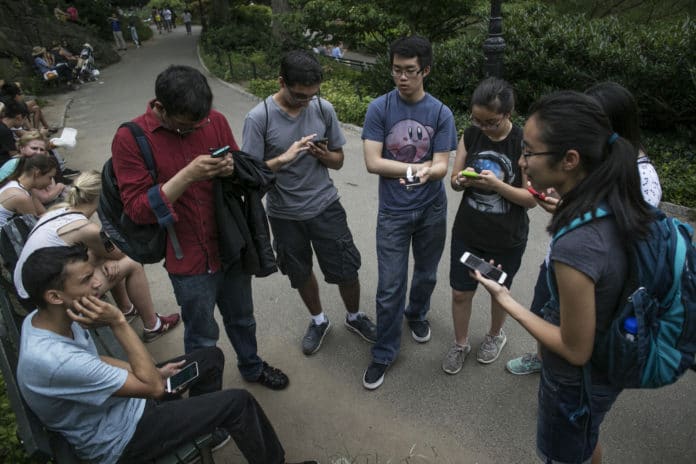Until last week, MacKenzie Olsberg’s nightly commute home from her office in Chicago involved taking a train to a bus and walking a short distance to her home. Now, she skips the bus portion and walks the last mile and a half.
All because of Pokémon Go.
“Since Pokémon came out, I’ve found that I’m a lot more engaged in what’s around, and I’ve frequently gotten off the beaten track just so I can get that Pokémon that’s nearby,” says Olsberg, who is 29. Then she deadpans: “I didn’t know there were so many Eevees around my house.” (For those of you who may not know, that’s a rare type of Pokémon).
Pokémon Go launched July 6, and the impact has been striking. Not just on neighborhoods across the United States – which filled with zombie-like players holding their cellphones like divining rods – but on step count.
All of a sudden, people were moving more in their quest to collect eggs from PokéStops, pelting critters (Drowzee, Pidgey, Zubat, Rattata and the like) with PokéBalls and waging battles in gyms, all in an augmented reality game that spreads Pokémon creatures throughout Everytown, USA.
The founders of Cardiogram, an app for Apple Watch that analyzes heart rate data, looked at heart rate and exercise information from 35,000 Cardiogram Apple Watch users, and saw an increase in users’ overall exercise the weekend after Pokémon Go launched. The exercise increase was across the board – the app makers have no way of knowing who was actually using Pokémon Go. On the day of the launch, about 45 percent of users were exercising 30 or more minutes. Two days later, on a Saturday, that number rose to 50 percent. The next day, it hit 53 percent.
“The fact that it’s a population-level effect that’s visible is actually pretty impressive on Pokémon Go’s part,” said Cardiogram co-founder Brandon Ballinger, who compares the increase to the spike seen the first week of January, when people are resolving to be more active. By the second week of January, he said, that activity began to decline.
Johnson Hsieh, who co-founded Cardiogram with Ballinger, added that his own step count has also risen since he started playing Pokémon Go.
“I walk to work and home every day and I definitely spend more time taking detours,” Hsieh said.
Jawbone, which makes the UP fitness tracker, took a closer look at its users who mentioned Pokémon Go in their comments (UP users can interact with friends through the app) and compared their steps the weekend after the launch with past weekends. The results: on average, the group that mentioned Pokémon Go was walking 62.5 percent more than usual. Users of Under Armour’s MyFitnessPal log workouts, like walking, running or biking. In recent days, they’ve started entering “Pokémon Go” as a workout, says Rebecca Silliman, director of communications with Under Armour Connected Fitness.
“Generally they burn about 250-300 calories a pop,” she said.
Mike Caldwell, co-founder of Pacer, an activity tracker app users download to their phone, says that his team looked at Pacer users younger than 30 and saw a 5 to 10 percent increase in daily steps, overall, since the Pokémon Go launch, compared with the previous week.
“Now, I can’t say with the data that we have that this increase is due to Pokémon Go,” Caldwell said in an email. “But if we just suppose for a moment that it were, that’s a remarkable change over an entire population.”
Pacer offers users the option to join groups for support, and Caldwell said that a number of Pokémon walking groups have formed across the country. He added that within the Pacer community, where users can comment and interact, the subject of Pokémon Go is coming up frequently.
One user wrote, “My son, 14, convinced me to download the Pokémon Go app and we spent two hours just walking around the park ‘collecting’ them all. After two hours I checked my phone and lo and behold 12,000 steps. What a great way to walk and spend some quality time with the kid I can’t drag away from his computer!” Another commented: “So haven’t walked in years. And overweight. So figured I would download this new game. . . . So tonight was my first walk. Caught a handful of Pokémon and walked 3.5 miles!! I’m proud of myself and feel good.”
Caldwell said Pokémon Go is changing the conversation around the development of health and fitness apps.
“There’s always been this idea that fitness and gaming could come together and make something special for users, and, frankly, it’s been tried by countless apps and companies before (even we incorporate some minor elements of gamification into our app),” he wrote. “But nobody has ever really broken through to such a mass audience before with such a compelling product. It really just shows that there’s still a lot of innovation left to be done in our domain.”






